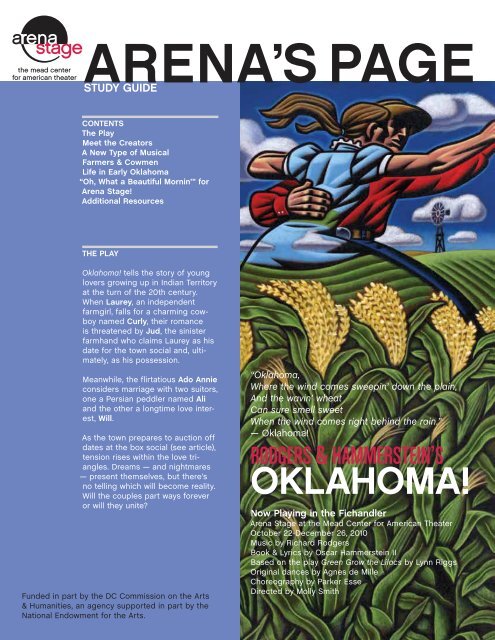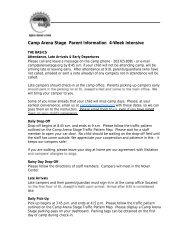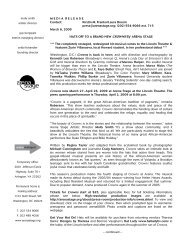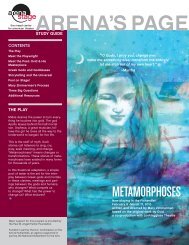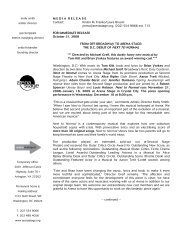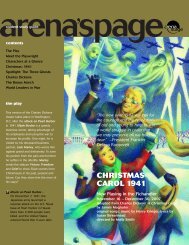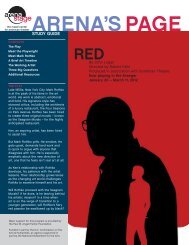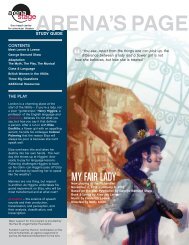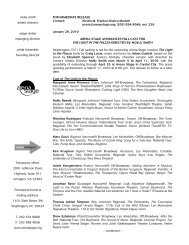OKLaHOMa! - Arena Stage
OKLaHOMa! - Arena Stage
OKLaHOMa! - Arena Stage
You also want an ePaper? Increase the reach of your titles
YUMPU automatically turns print PDFs into web optimized ePapers that Google loves.
arena’s page<br />
study guide<br />
Contents<br />
The Play<br />
Meet the Creators<br />
A New Type of Musical<br />
Farmers & Cowmen<br />
Life in Early Oklahoma<br />
“Oh, What a Beautiful Mornin’” for<br />
<strong>Arena</strong> <strong>Stage</strong>!<br />
Additional Resources<br />
The Play<br />
Oklahoma! tells the story of young<br />
lovers growing up in Indian Territory<br />
at the turn of the 20th century.<br />
When Laurey, an independent<br />
farmgirl, falls for a charming cowboy<br />
named Curly, their romance<br />
is threatened by Jud, the sinister<br />
farmhand who claims Laurey as his<br />
date for the town social and, ultimately,<br />
as his possession.<br />
Meanwhile, the flirtatious Ado Annie<br />
considers marriage with two suitors,<br />
one a Persian peddler named Ali<br />
and the other a longtime love interest,<br />
Will.<br />
As the town prepares to auction off<br />
dates at the box social (see article),<br />
tension rises within the love triangles.<br />
Dreams — and nightmares<br />
— present themselves, but there’s<br />
no telling which will become reality.<br />
Will the couples part ways forever<br />
or will they unite<br />
Funded in part by the DC Commission on the Arts<br />
& Humanities, an agency supported in part by the<br />
National Endowment for the Arts.<br />
“Oklahoma,<br />
Where the wind comes sweepin’ down the plain,<br />
And the wavin’ wheat<br />
Can sure smell sweet<br />
When the wind comes right behind the rain.”<br />
— Oklahoma!<br />
Rodgers & Hammerstein’s<br />
OKLAHOMA!<br />
Now Playing in the Fichandler<br />
<strong>Arena</strong> <strong>Stage</strong> at the Mead Center for American Theater<br />
October 22-December 26, 2010<br />
Music by Richard Rodgers<br />
Book & Lyrics by Oscar Hammerstein II<br />
Based on the play Green Grow the Lilacs by Lynn Riggs<br />
Original dances by Agnes de Mille<br />
Choreography by Parker Esse<br />
Directed by Molly Smith
Meet the Creators:<br />
Richard Rodgers (music)<br />
and<br />
Oscar Hammerstein II<br />
(book & lyrics)<br />
“Not only is Oklahoma! the most important of the Rodgers and<br />
Hammerstein musicals, it is also the single most influential work in<br />
the American musical theater.”– Thomas Hischak, playwright and theater writer<br />
A New Type of Musical<br />
Before Oklahoma!, most musicals were a series of jokes strung together to showcase<br />
the main attraction: the songs or, in some cases, the star. Oklahoma! marks a major<br />
change in musical form.<br />
It is the first musical of its kind: a book musical. Each song and dance is part of a<br />
story that has a beginning, middle and end. It also demonstrates the emotional depths<br />
of its characters and deals with serious social issues, like land disputes and violence.<br />
Whenever I get an idea for a song,<br />
even before jotting down the notes,<br />
I can hear it in the orchestra; I can<br />
smell it in the scenery; I can see<br />
the kind of actor who will sing it;<br />
and I am aware of an audience<br />
listening to it.”<br />
— Richard Rodgers<br />
Better known as simply<br />
Rodgers & Hammerstein: the<br />
creators of Oklahoma! are<br />
the most famous partnership in<br />
American musical theater.<br />
Before they were Rodgers &<br />
Hammerstein, Richard Rodgers<br />
began playing the piano at age 6.<br />
During his early teenage years, he<br />
attended a summer camp where he<br />
composed some of his first songs.<br />
Meanwhile, Oscar Hammerstein’s<br />
father disapproved of his<br />
son’s desire to pursue theater.<br />
Nonetheless, Hammerstein dropped<br />
out of law school to do so.<br />
Both men grew up in New York City<br />
and attended the same college,<br />
although they didn’t know each<br />
other at the time. After meeting<br />
in 1943, they went on to have a<br />
fruitful partnership because their<br />
working styles fit together well:<br />
Hammerstein preferred to write<br />
a complete lyric (words) before<br />
it was set to music, and Rodgers<br />
preferred to set completed lyrics to<br />
music.<br />
Together, Rodgers and<br />
Hammerstein created awardwinning,<br />
beloved musicals like<br />
Carousel; South Pacific; The King<br />
and I and The Sound of Music. l<br />
Oklahoma! features another element new to musicals: the dream ballet. A dance number<br />
showcasing major themes of the story, the dream ballet does not contain any<br />
singing or speaking. The dream sequence is significant because it brought dance to a<br />
nearly equal level of importance as text and song. l<br />
Box Socials<br />
“Wake up, Laurey. It’s time to start fer the party.”<br />
— Jud Fry, Oklahoma!<br />
A box social was a dance or<br />
fundraiser for an organization, like a<br />
school or church. Women decorated<br />
cardboard boxes or lunch hampers<br />
that held enough food for two<br />
people. At the dance, men would bid<br />
against one another for the box of<br />
their choice. The prize for the highest<br />
bidder Sharing the meal in the box<br />
with the woman who made it. l<br />
Farmers and Cowmen<br />
What is a surrey<br />
A surrey is a horsedrawn<br />
carriage<br />
typically ridden for<br />
pleasure and not<br />
for traveling long<br />
distances. What<br />
would owning a<br />
surrey symbolize for<br />
a farmer or cowboy in<br />
Oklahoma<br />
Most settlers that arrived after the land runs in the late 1800s farmed, growing<br />
crops to make a living or provide food for their families. At the same time<br />
ranchers and cowboys had cattle that grazed freely on the open range<br />
(government-owned land), sometimes eating farmers’ crops or trampling young plants.<br />
These conflicting livelihoods led to competition for land and clashes between farmers<br />
and ranchers. l<br />
The invention of barbed wire escalated rancher-farmer relationships. It separated one<br />
person’s land from another and established property lines that, if crossed by a trespasser,<br />
could be punishable by law. Some ranchers who grazed their cattle on the open range started<br />
cutting fences to be able to drive their cattle between tracts of state land and to water.<br />
ACTIVITY: Look through headlines in a recent newspaper to find some articles<br />
about territory laws or conflicts. What strategy would you use to negotiate<br />
between the opposing groups How are these issues like or unlike the<br />
disagreements between the ranchers and farmers
Life in Early Oklahoma<br />
The first settlers in the new territory generally did not have<br />
enough money or materials to build wooden houses.<br />
Often, they would live in makeshift dugouts or sod<br />
houses, which were shelters built out of soil and grass. Their<br />
first crops usually did not grow well, and sometimes turnips<br />
were the main food available for the settlers to eat.<br />
Even when rural areas and towns began to prosper<br />
economically by the early 1900s, Oklahoma’s residents<br />
still struggled to make ends meet. l<br />
ACTIVITY: Imagine that you have just settled in<br />
a new territory during the late 1800s in<br />
Oklahoma. Write a journal entry describing<br />
your experiences.<br />
The costumes have<br />
details to make them<br />
seem authentic to<br />
Oklahoma in the early<br />
1900s. Since the<br />
characters do not have<br />
much money, you may<br />
notice clothes that<br />
look mended or old.<br />
Altering a garment to<br />
make it seem less new<br />
is called distressing.<br />
A craftsperson may<br />
artfully wash, wrinkle,<br />
paint, beat or even tear<br />
a costume piece to<br />
make it seem lived-in.<br />
“They gonna make a state outta this territory, they gonna put it in the Union!”<br />
— Curly McLain, Oklahoma!<br />
Once called Indian and Oklahoma Territories,<br />
the two combined and Oklahoma was<br />
declared a state on November 16, 1907.<br />
How is land purchased In 1889, Congress passed laws allowing white settlers to purchase Oklahoma<br />
land on a first-come, first-served basis. This race for land (and a new future!) was called a land run.
“Oh, What a Beautiful Mornin’” For <strong>Arena</strong> <strong>Stage</strong>!<br />
<strong>Arena</strong> <strong>Stage</strong> is opening the doors to its new theater complex,<br />
the Mead Center for American Theater, with Oklahoma!<br />
You will be among the first audiences in the<br />
building, which houses <strong>Arena</strong>’s two<br />
historic theaters – the Fichandler<br />
& the Kreeger – and a new<br />
theater, the Kogod<br />
Cradle.<br />
ACTIVITY: Here is the Fichandler <strong>Stage</strong>, a theater-in-the round<br />
with the audience on all sides. How would you change the<br />
space into the setting for Oklahoma! Keep in mind that you<br />
must not block views from the audience!<br />
Helpful Hints for Theater Audiences<br />
As an audience member at the theater,<br />
YOU are part of the show! Just as you<br />
see and hear the actors onstage, they<br />
can see and hear you in the audience.<br />
To help the performers do their best,<br />
please remember the following:<br />
Arrive at least 30 minutes early.<br />
Visit the restroom before the show starts.<br />
Before the show begins, turn off your<br />
cell phone, watch alarms, pagers<br />
and other electronic devices. If<br />
anything rings by accident, shut it off<br />
immediately.<br />
Save food and drinks for the lobby.<br />
There is no eating or drinking inside<br />
the theater.<br />
Walk to and from your seat - no<br />
running in the theater!<br />
Do not talk, whisper, sing or hum.<br />
Do not use cell phones for calls, text<br />
messages, pictures or games.<br />
Keep your feet on the floor, not on<br />
the seat in front of you.<br />
Avoid getting up during a show<br />
because it distracts your neighbors<br />
and the performers. If you must leave,<br />
wait for a scene change, then exit<br />
quietly and quickly.<br />
Performers appreciate enthusiastic<br />
applause rather than whistling or<br />
shouting.<br />
Cameras and videotape are<br />
prohibited because they are<br />
distracting to the performers.<br />
Enjoy the show!<br />
Additional Resources<br />
Books/Plays<br />
Green Grow the Lilacs by Lynn Riggs<br />
North Central Oklahoma: Rooted in the Past, Growing for the Future by the North<br />
Central Oklahoma Historical Association<br />
Oklahoma!: The Making of an American Musical by Tim Carter<br />
The Cowboy Encyclopedia by Richard W. Slatta<br />
On the Web:<br />
Technology in 1900: www.pbskids.org/wayback/tech1900/<br />
The Musical: www.broadwaymusicalhome.com/shows/oklahoma.htm<br />
Cowboy Museum: www.nationalcowboymuseum.org<br />
On DVD:<br />
Oklahoma! film adaptation: CBS Video, 1955<br />
Real West: Cowboys & Outlaws documentary: History Channel, 2008<br />
Museum Exhibits<br />
Communities in a Changing Nation: The Promise of 19th-Century America,<br />
Ongoing at the National Museum of American History<br />
Our Peoples: Giving Voice to Our Histories at the<br />
National Museum of the American Indian<br />
1101 Sixth Street, SW<br />
Washington, DC 20024<br />
Phone: (202) 554-9066<br />
Fax: (202) 488-4056<br />
Community Engagement<br />
Phone: 202-234-5782<br />
Fax: 202-797-1043<br />
Written by Julia DePalma<br />
Edited by Rebecca Campana<br />
Illustration by Doug Fraser<br />
Visit www.arenastage.org<br />
for more information on<br />
<strong>Arena</strong> <strong>Stage</strong> productions<br />
and educational opportunities.


